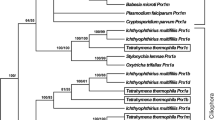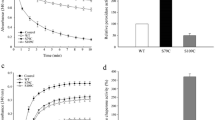Abstract
Many proteins have been isolated from eukaryotes as redox-sensitive proteins, but whether these proteins are present in prokaryotes is not clear. Redox-sensitive proteins contain disulfide bonds, and their enzymatic activity is modulated by redox in vivo. In the present study, we used thiol affinity purification and mass spectrometry to isolate and identify 19 disulfide-bond-containing proteins in Pseudomonas putida exposed to potential oxidative damages. Among these proteins, we found that a typical 2-Cys Prx-like protein (designated PpPrx) displays diversity in structure and apparent molecular weight (MW) and can act as both a peroxidase and a molecular chaperone. We also identified a regulatory factor involved in this structural and functional switching. Exposure of pseudomonads to hydrogen peroxide (H2O2) caused the protein structures of PpPrx to convert from high MW complexes to low MW forms, triggering a chaperone-to-peroxidase functional switch. This structural switching was primarily guided by the thioredoxin system. Thus, the peroxidase efficiency of PpPrx is clearly associated with its ability to form distinct protein structures in response to stress.





Similar content being viewed by others
References
Alphey MS, Bond CS, Tetaud E, Fairlamb AH, Hunter WN (2000) The structure of reduced tryparedoxin peroxidase reveals a decamer and insight into reactivity of 2 Cys-peroxiredoxins. J Mol Biol 300:903–916
Bentley NJ, Fitch IT, Tuite MF (1992) The small heat-shock protein Hsp26 of Saccharomyces cerevisiae assembles into a high molecular weight aggregate. Yeast 8:95–106
Bradford MM (1976) A rapid and sensitive method for the quantitation of microgram quantities of protein utilizing the principle of protein-dye binding. Anal Biochem 72:248–254
Brown SM, Howell ML, Vasil ML, Anderson AJ, Hassett DJ (1995) Cloning and characterization of the katB gene of Pseudomonas aeruginosa encoding a hydrogen peroxide-inducible catalase: purification of KatB, cellular localization, and demonstration that it is essential for optimal resistance to hydrogen peroxide. J Bacteriol 177:6536–6544
Burgess SA, Walker ML, Thirumurugan K, Trinick J, Knight PJ (2004) Use of negative stain and single-particle image processing to explore dynamic properties of flexible macromolecules. J Struct Biol 147:247–258
Butterfield DA, Yatin SM, Varadarajan S, Koppal T (1999) Amyloid beta-peptide-associated free radical oxidative stress, neurotoxicity, and Alzheimer’s disease. Methods Enzymol 309:746–768
Chae HZ, Robison K, Poole LB, Church G, Storz G, Rhee SG (1994) Cloning and sequencing of thiol-specific antioxidant from mammalian brain: alkyl hydroperoxide reductase and thiol-specific antioxidant define a large family of antioxidant enzymes. Proc Natl Acad Sci USA 91:7017–7021
Chauhan R, Mande SC (2001) Characterization of the Mycobacterium tuberculosis H37Rv alkyl hydroperoxidase AhpC points to the importance of ionic interactions in oligomerization and activity. J Biochem 354:209–215
Cheong NE, Choi YO, Lee KO, Kim WY, Jung BG, Chi YH, Jeong JS, Kim K, Cho MJ, Lee SY (1999) Molecular cloning, expression, and functional characterization of a 2Cys-peroxiredoxin in Chinese cabbage. Plant Mol Biol 40:825–834
Choi H, Kim S, Mukhopadhyay P, Cho S, Woo J, Storz G, Ryu S (2001) Structural basis of the redox switch in the OxyR transcription factor. Cell 105:103–113
Chuang MH, Wu MS, Lo WL, Lin JT, Wong CH, Hiou SH (2006) The antioxidant protein alkylhydroperoxide reductase of Helicobacter pylori switches from a peroxide reductase to a molecular chaperone function. Proc Natl Acad Sci USA 103:2552–2557
Cumming RC, Andon NL, Haynes PA, Park MK, Fischer WH, Schubert D (2004) Protein disulfide bond formation in the cytoplasm during oxidative stress. J Biol Chem 279:21749–21758
Gardy JL, Laird MR, Chen F, Rey S, Walsh CJ, Ester M, Brinkman FSL (2005) PSORTb v.2.0: expanded prediction of bacterial protein subcellular localization and insights gained from comparative proteome analysis. Bioinformatics 21:617–623
Graumann J, Lilie H, Tang X, Tucker KA, Hoffmann JH, Vijayalakshmi J, Saper M, Bardwell JC, Jakob U (2001) Activation of the redox-regulated molecular chaperone hsp33-a two-step mechanism. Structure (Camb) 9:377–387
Groenen PJTA, Merck KB, de Jong WW, Bloemendal H (1994) Sturcture and modifications of the junior chaperone alpha-crystallin. From lens transparency to molecular pathology. Eur J Biochem 225:1–19
Haley D, Horwitz J, Stewart PL (1998) The small heat shock protein, αB-crystallin, has a variable quaternary structure. J Mol Biol 277:27–35
Hartl FU (1996) Molecular chaperone in cellular protein folding. Nature 381:571–580
Hendrick JP, Hartl FU (1993) Molecular chaperone functions of heat shock proteins. Annu Rev Biochem 62:349–384
Hirotsu S, Abe Y, Okada K, Nagahara N, Hori H, Nishino T, Hakoshima T (1999) Crystal structure of a multifunctional 2-Cys peroxiredoxin heme-binding protein 23 kDa/proliferation-associated gene product. Proc Natl Acad Sci USA 96:12333–12338
Hofmann B, Hecht HJ, Flohé L (2002) Peroxiredoxins. Biol Chem 383:347–364
Jang HH, Lee KO, Chi YH, Jung BG, Park SK, Park JH, Lee JR, Lee SS, Moon JC, Yun JW, Choi YO, Kim WY, Kang JS, Cheong GW, Yun DJ, Rhee SG, Cho MJ, Lee SY (2004) Two enzymes in one; two yeast peroxiredoxins display oxidative stress-dependent switching from a peroxidase to a molecular chaperone function. Cell 117:625–635
Jang HH, Chi YH, Park SK, Lee SS, Lee JR, Park JH, Moon JC, Lee YM, Kim SY, Lee KH, Lee SY (2006) Structural and functional regulation of eukaryotic 2-Cys peroxiredoxins including the plant ones in cellular defense signaling mechanisms against oxidative stress. Physiol Plant 126:549–559
Jennifer LG, Cory S, Ke W, Martin E, Gabor ET, Istvan S, Sujun H, Katalin D, Christophe L, Kenta N, Brinkman FSL (2003) PSORT-B: improving protein subcellular localization prediction for Gram-negative bacteria. Nucleic Acids Research 31:3613–3617
Jeong WJ, Cha MK, Kim IH (2000) A new member of human Tsa/AhpC as thioredoxin-dependent thiol peroxidase. J Biochem Mol Biol 33:234–241
Kim KK, Kim R, Kim S-H (1998) Crystal structure of a small heat-shock protein. Nature 394:595–599
Kim KS, Choi SY, Kwon HY, Won MH, Kang TC, Kang JH (2002) Aggregation of α-synuclein induced by the Cu, Zn-superoxide dismutase and hydrogen peroxide system. Free Radic Biol Med 32:544–550
Kitano K, Niimura Y, Nishiyama Y, Miki K (1999) Stimulation of peroxidase activity by decamerization related to ionic strength: ahpC protein from Amphibacillus xylanus. J Biochem (Tokyo) 126:313–319
Kristensen P, Rasmussen DE, Kristensen BI (1999) Properties of thiol-specific anti-oxidant protein or calpromotin in solution. Biochem Biophys Res Commun 262:127–131
Lee GJ, Roseman AM, Saibil HR, Vierling E (1997) A small heat shock protein stably binds heat-denatured model substrates and can maintain a substrate in a folding-competent state. J EMBO 16:659–671
Lee K, Lee J, Kim Y, Bae D, Kang KY, Yoon SC, Lim D (2004) Defining the plant disulfide proteome. Electrophoresis 25:532–541
Leroux MR, Melki R, Gordon B, Batelier G, Candido EPM (1997) Structure-function studies on small heat shock protein oligomeric assembly and ineraction with unfold polypeptides. J Biol Chem 272:24646–24656
Maher P, Schubert D (2000) Signaling by reactive oxygen species in the nervous system. Cell Mol Life Sci 57:1287–1305
Moon JC, Hah YS, Kim WY, Jung BG, Jang HH, Lee JR, Kim SY, Lee YM, Jeon MK, Kim CW, Cho MJ, Lee SY (2005) Oxidative stress-dependent structural and functional switching of a human 2-Cys peroxiredoxin isotype II that enhances HeLa cell resistance to H2O2-induced cell death. J Biol Chem 280:28775–28784
Schröder E, Littlechild JA, Lebedev AA, Errington N, Vagin AA, Isupov MN (2000) Crystal structure of decameric 2-Cys peroxiredoxin from human erythrocytes at 1.7 Å resolution. Structure 8:605–615
Storz G, Tartaglia LA, Farr SB, Ames BN (1990) Bacterial defenses against oxidative stress. Trends Genet 6:363–368
Waters ER, Lee GJ, Vierling E (1996) Evolution, structure and function of the small heat shock proteins in plants. J Exp Bot 47:325–338
Wood ZA, Schröder E, Robin HJ, Poole LB (2003) Structure, mechanism and regulation of peroxiredoxins. Trends Biochem Sci 28:32–40
Acknowledgments
This project was carried out under the Nuclear R&D Program of the Ministry of Science and Technology (http://WWW.mest.go.kr), Republic of Korea. EM work was supported by KBSI grant T3021A to Jung, HS.
Author information
Authors and Affiliations
Corresponding author
Electronic supplementary material
Below is the link to the electronic supplementary material.
Supplementary Fig. 1
A Each SEC fraction was separated by 10% native-PAGE. B Each SEC fraction was separated by 12% non-reducing-PAGE. PpPrx recombinant protein was stained with Coomassie Brilliant Blue R-250. F-1 lane F-1 fraction of PpPrx, F-2 lane F-2 fraction of PpPrx (GIF 61 kb)
Rights and permissions
About this article
Cite this article
An, B.C., Lee, S.S., Lee, E.M. et al. Functional switching of a novel prokaryotic 2-Cys peroxiredoxin (PpPrx) under oxidative stress. Cell Stress and Chaperones 16, 317–328 (2011). https://doi.org/10.1007/s12192-010-0243-5
Received:
Revised:
Accepted:
Published:
Issue Date:
DOI: https://doi.org/10.1007/s12192-010-0243-5




